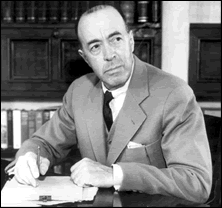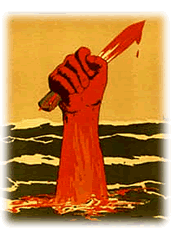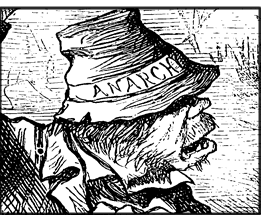Edgar Rice Burroughs on War and Race:
The Case of Beyond Thirty.
"There once were two cats of Kilkenny
Each thought there was one cat too many
So they fought and they hit
And they scratched and they bit
'Til instead of two cats there weren't any!"
By Ron Fritze
November 5, 2007
Edgar Rice Burroughs, or ERB, is best known as the creator of the fictional character of Tarzan, who has been an enduring icon of popular culture for almost one hundred years. Besides Tarzan, Burroughs (1875-1950) created many other fictional characters, who adventured on Mars, Venus, the Earth's core, various lost continents, and times future and past.
 Although his fiction was frequently formulaic, Burroughs produced many enjoyable reads. He is one of the patriarchs of American science fiction. Librarians at one time banished his books from the shelves of public libraries as trashy and bad influences on their readers, but such an exile only transformed the novels into a sort of forbidden fruit.
Although his fiction was frequently formulaic, Burroughs produced many enjoyable reads. He is one of the patriarchs of American science fiction. Librarians at one time banished his books from the shelves of public libraries as trashy and bad influences on their readers, but such an exile only transformed the novels into a sort of forbidden fruit.
A Link with Dad through Reading.
I must confess a fondness for Edgar Rice Burroughs — his books in particular and science fiction in general. I was a reader from early on, but when I discovered science fiction in my youth, I was transformed into a voracious reader, and have remained one ever since. Reading Edgar Rice Burroughs also gave me a link with my Dad. He had enjoyed reading Burroughs when he was growing up, and told me how he and his friends would read the books in a tree-house. It was fun to have that shared experience of boyhood across the generations.
My days of reading science fiction for recreational purposes came to a close in college when from necessity (and personal interest) I began to read history books as fast as I could absorb them. I also learned more and more about the value of primary sources, the building blocks of historical research. Historians have come to realize that popular songs, graffiti, movies, and comic books can all be effectively used as primary sources to help us better understand and appreciate the past.
Just recently, I got a lesson on how an obscure little novel by Edgar Rice Burroughs can become more than just a good read when it's viewed with the hindsight of history. It entertains, sure, but it also provides insight into American society at the beginning of World War I in Europe by revealing attitudes toward war and race. The novel is Beyond Thirty, which was first published in the February 1916 issue of All-Around Magazine. Burroughs wrote the tale between 8 July and 10 August 1915, then sent it to All-Story Magazine, the venue he favored for his stories. When their editors rejected it in September, he shopped the novel to his second choice. Closely connected to the events of World War I, Beyond Thirty quickly became dated. It was never republished in ERB's lifetime.

New Title,
Racy Cover.
Then in 1963, at a time when Edgar Rice Burrough's reputation was experiencing a pop-culture revival, Ace Books reprinted the text of Beyond Thirty under the more compelling title of The Lost Continent. The book featured a typically racy cover by the science fiction and fantasy illustrator Frank Frazetta.
In 2001 the novel surfaced again, this time thanks to academic interests. The University of Nebraska Press reprinted the book as part of its Bison Frontiers of Imagination series of classic science fiction, but under its original title Beyond Thirty. This edition includes a scholarly introduction and a couple of scholarly essays about the book — but, alas, no racy Frazetta cover.
Beyond Thirty. What kind of title is that? What if it had been coined in the Sixties, that era of "trust no one over thirty?" Some potential readers might have been fooled into thinking it was a novel about getting old and moving from enlightened youth to benighted middle age.
A Pan-American Hero in 2137.
In fact, the title makes perfectly good sense once the reader has gotten just a few pages into the first chapter and realizes that it refers not to age but to geography. The story is set in the year 2137. Its hero is Jefferson Turck, a Pan-American. He lives in a closed society with roots that extend all the way back to the historical and terrible World War I, which broke out in Europe in 1914.
 In Burrough's imagination, the First World War degenerates into a bloody struggle of mutual annihilation for the Europeans. Hoping to avoid being drug into the European conflagration, the nations of the Western Hemisphere unite in the Pan-American Federation. They also decide to cut themselves off from the warlike Old World, and in 1921 contact is banned. By 1922 things have become so bad that transoceanic travel has ceased. After the last hostile submarine makes a failed attempt to sink a Brazilian ship, contact is totally broken, and knowledge of events in the Eastern Hemisphere slips into the vague realm of rumor and speculation. Then, total silence.
In Burrough's imagination, the First World War degenerates into a bloody struggle of mutual annihilation for the Europeans. Hoping to avoid being drug into the European conflagration, the nations of the Western Hemisphere unite in the Pan-American Federation. They also decide to cut themselves off from the warlike Old World, and in 1921 contact is banned. By 1922 things have become so bad that transoceanic travel has ceased. After the last hostile submarine makes a failed attempt to sink a Brazilian ship, contact is totally broken, and knowledge of events in the Eastern Hemisphere slips into the vague realm of rumor and speculation. Then, total silence.
The territories of the Pan-American Federation are set between 30 degrees west longitude and 175 degrees west longitude. No one from outside that area is allowed to enter and no one from inside that area is allowed to leave. The penalty for violation is death. Two hundred years after the total break with the Old World, the navy of the Pan-American Federation continues to patrol the boundaries for violations and trespassers. Jefferson Turck is an officer in that navy and the descendent of a long line of Federation naval officers.
Lions and Tigers in London O My!
As the commander of a flying submarine patrolling the Atlantic, Turck is caught up in a storm and forced to sail beyond 30 degrees. It is a great crime. Turck and three of his crew are abandoned at sea by the flying submarine and make their way to England. There they discover that civilization has collapsed back into a primitive, stone-age society of survivors. Animals have escaped from the zoos to reclaim the world. Lions and tigers stalk the ruins of London along with elephants and herds of antelope.
Everywhere are the evidences of the great struggle that destroyed civilization. It is a Hobbesian world in which the strangers are assumed to be enemies and power is gained by violence and treachery. The redoubtable Turck still manages, in the tradition of good Burroughsian heroes, to bond with a comely and friendly local girl named Victoria. Their travels carry them to the continent where they find that civilization has collapsed there as well. A few primitives roam the ruins, speaking mongrel versions of French and German.
Then, Turck is captured by some black African soldiers, who enslave him.
 He has reached the outposts of the great Abyssinian Empire. While he does not like being a slave, Turck finds his captors to be honorable and civilized. He also finds out that they are engaged in war with a deadly enemy, and that they are losing the struggle. The enemy is steadily pushing them out of Europe and back to Africa. That enemy turns out to be the Chinese, who rescue Turck and Victoria from their African captors. The Chinese prove even more civilized and nicer than the Africans, and help Turck return home. There great change has occurred. The Pan-Americans have decided to forego their isolationist ways. Turck is now a hero. The earth is restored to political wholeness once again.
He has reached the outposts of the great Abyssinian Empire. While he does not like being a slave, Turck finds his captors to be honorable and civilized. He also finds out that they are engaged in war with a deadly enemy, and that they are losing the struggle. The enemy is steadily pushing them out of Europe and back to Africa. That enemy turns out to be the Chinese, who rescue Turck and Victoria from their African captors. The Chinese prove even more civilized and nicer than the Africans, and help Turck return home. There great change has occurred. The Pan-Americans have decided to forego their isolationist ways. Turck is now a hero. The earth is restored to political wholeness once again.
Isolationism, Scientific Racism.
Beyond Thirty is an interesting historical document for a couple of reasons. First, it exemplifies traditional American isolationism at its best. We live today in a world where the United States is widely viewed, fairly or unfairly, as an imperialist and militaristic nation. Burroughs in 1914 lived in a world where the United States was barely imperialistic and definitely not militaristic. The vices of imperialism and war-mongering were viewed as distinctly European. Most Americans in 1914 just wanted to stay out of Europe's bloody squabbles. They feared that the conflict of the First World War could rage out of control and destroy civilization, so Burroughs was addressing a prevalent societal fear in Beyond Thirty.
Second, when Burroughs wrote Beyond Thirty in 1915, American and European society were both in the grip of scientific racism and the prejudices it encouraged.
 It was the year that D. W. Griffith's film, Birth of a Nation, was released to critical acclaim, helping to promote the revival of the Ku Klux Klan, which peaked in the early 1920s with many-thousand-man marches on Washington. Blacks were viewed as bestial savages who needed to be controlled. They were seen as being incapable of attaining and maintaining civilization on their own. They could not govern themselves, according to this viewpoint, and thus needed white people to take care of them and rule them with wisdom and benevolence.
It was the year that D. W. Griffith's film, Birth of a Nation, was released to critical acclaim, helping to promote the revival of the Ku Klux Klan, which peaked in the early 1920s with many-thousand-man marches on Washington. Blacks were viewed as bestial savages who needed to be controlled. They were seen as being incapable of attaining and maintaining civilization on their own. They could not govern themselves, according to this viewpoint, and thus needed white people to take care of them and rule them with wisdom and benevolence.
East Asians were also not well thought of by the white people of this era. There was a grave fear of the "yellow peril." Japan had handily defeated Russia in the Russo-Japanese War of 1905, a startling turn of events that some viewed as an alarming instance of a non-white race defeating a supposedly superior white race. Apologists for the ideology of white supremacy quickly explained the Russian humiliation by casting doubts on the purity of Russian whiteness — the too-much-raping-by-Mongol-hordes-creates-mongrels excuse. In other circles, the non-whites rejoiced at the Japanese victory. Europeans and Americans, however, fretted about the deluge of yellow Asiatics eager to engulf white Christian civilization.
A Contradictory View of Racial Issues.
How did Burroughs handle the issues of race? That is a contentious question because ERB dealt with racial issues in contradictory ways. Readers of Tarzan novels know that the black Africans are frequently portrayed as crude and dim-witted savages. On the other hand, Tarzan's friends and allies of the Waziri tribe are noble and honorable people with an outstanding warrior tradition.
What about the Africans in Beyond Thirty? Again, Burroughs sends his readers a mixed message. As his Turck describes the people of the Abyssinian Empire of Africa:
"The Abyssinians themselves are a fine looking race of black men — tall, muscular, with fine teeth, and regular features, which incline distinctly toward Semitic mold — I refer to the full-blooded natives of Abyssinia. They are the patricians — the aristocracy. The army is officered almost exclusively by them. Among the soldiery a lower type of negro predominates, with thicker lips and broader, flatter noses. These men are recruited . . . from among the conquered tribes of Africa. They are good soldiers — brave and loyal. . . . On the whole, it is apparent that the black race has thrived far better in the past two centuries under men of its own color than it had under the domination of whites during all previous history."
'Semitic' Blacks Become Slave Masters.
The fictional Abyssinian Empire of the novel is also Christian and is committed to bringing Christianity back to a barbaric Europe that has fallen into the darkness of heathenism. But it is also a slave society with ten to fifteen million white slaves. As Jefferson Turck narrates it, "They looked upon the whites as their inferiors and treated us accordingly." Burroughs' Africans comprise a society dominated by an elite cadre of Abyssinians, whose traits stand in sharp contrast to the prevailing stereotype of the American negro. They are "Semitic" in appearance. Apparently the Africans of Burrough's Abyssinian Empire are not capable of creating a more egalitarian society.
Burroughs spends less time on the Chinese. They are at war with the Africans and defeat them at Berlin. During the battle Turck and Victoria escape their Abyssinian masters and fall into the hands of the Chinese. Although Turck and Victoria are now the prisoners of the Chinese, they receive much better treatment than they did at the hands of the Africans.
Turck is also able to persuade an educated Chinese officer that he is a Pan-American naval officer. That realization gets him and Victoria an audience with the Chinese emperor, who is anxious to reopen contact with Pan-America. In fact, the Chinese and Pan-Americans do come together and become allies in the process of reviving shattered and humbled Europe. As Turck put it:
"A new epoch for Europe is inaugurated, with enlightened China on the east and enlightened Pan-America on the west — the two great peace powers whom God preserved to regenerate chastened and forgiven Europe."
Turck, of course, marries Victoria, who happens to be the descendent of British royalty — and everyone lives happily ever after. But what about those Abyssinians? Apparently, they are forgotten in Burroughs conclusion.
Where Can We Hide?
Beyond Thirty is an artifact of the old world of 1915 and 1916. The march of history quickly rendered its cultural references obsolete and apparently irrelevant. But today, nearly a hundred years later, the novel retains its favor among a segment of the reading public. What does it say to us now?
For people living in a post 9-11 world, the idea of not venturing beyond thirty — and not letting outsiders pass within thirty, where they might threaten our side of the great divide — is a prospect that appeals to a certain stream of wishful thinking.
"To like and to dislike the same things,
that is indeed true friendship."
— Sallust (86-35 BC)
Click on the black panther to read Ron Fritze's previous essay,
"Elizabeth: The Glitzy Outrage."
|




